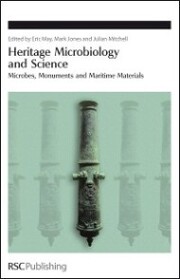-
Zusatztext
-
Heritage Science is emerging as a discipline that brings together chemists, physicists, microbiologists, conservation scientists, archaeologists and conservators. Its scope, precise boundaries and the interfaces between its component disciplines may be in a state of flux but, above all, its interdisciplinary nature offers understanding of the causes, control and protection of heritage from ever-present environmental challenges. In particular, the activities of microbes play a central part in shaping the natural world of our planet but this awesome power constitutes a serious threat to the integrity of our most precious art, heritage artefacts, monuments and cultural treasures. Heritage artefacts that have been recovered from water, or that exist near the sea in maritime conditions, pose special conservation problems due in main to the combined effect of microbial activities and physical/chemical assaults that the environment can offer. This book is a result of the invited and updated papers from HMS2005: Microbes, Monuments and Maritime Materials and forms a comprehensive volume that addresses key topical areas of heritage science and discusses the threats to a wide range of heritage materials and monuments by biological and chemical agents of decay. Key features of the book include: "Up-to-date summaries on the conservation of internationally-important artefacts and monuments "Clear outline of molecular techniques to identify microbes in environmental heritage samples "Wide range of case studies covering wood, stone, cave and cave paintings "Contributions presented as fully referenced research publications giving useful technical details and identification of areas for future study "Informs conservators about the threats from microbes to a range of materials "Extensive range of case studies of important world heritage artefacts and monuments as well as an overview of in situ preservation of historic ships "Provides background knowledge on the use and application of modern analytical techniques in conservation "Contains detailed information on molecular and synchrotron techniques to assist with identifying biological and chemical threats to heritage artefacts and monuments The book also provides up-to-date information on subjects covering the component field of heritage microbiology, molecular and chemical analytical techniques, and the mechanisms of degradation and deterioration of historic ships and buildings. The book details state-of-the-art techniques for the study of large and small heritage objects, and their conservation. Techniques cover the use of GIS image processing, molecular biological analysis of environmental samples including FISH, electrophoresis to remove corrosive ions and synchrotron radiation to detect chemicals present in artefacts. Several authors have developed their methods through involvement in international collaborative projects such as BIOBRUSH, BACPOLES and Save the Vasa. Extensive emphasis is placed on case studies and there is a valuable section on historic ships covering the preservation of HMS Victory, ss Great Britain, Vasa and the Mary Rose. This book provides an indispensable guide and reference source for those working in all areas of historical conservation, biodeterioration, microbiology and materials science.
-
-
Kurztext
-
Comprehensively covers the key topical areas of heritage science and discusses the threats to a wide range of heritage materials and monuments by biological and chemical agents of decay.
-
-
Autorenportrait
- Eric May is Reader in Microbiology at the School of Biological Sciences, University of Portsmouth. He has been known for his work on the role of bacteria in stone deterioration for 20 years but also recently coordinated an EU study to assess the value of biotechnology for remediation of altered stone in buildings (BIOBRUSH). He chaired the scientific committees and organised the international heritage meeting Heritage Microbiology and Science (HMS 2005) in Portsmouth in June 2005 along with Mark Jones at the Mary Rose Trust. He is co-editor of Conservation Science: Heritage Materials and was a participant in a recent Preserving the Past research initiative that looked at the methods used in heritage and conservation work. Mark Jones is Head of Collections at the Mary Rose Trust. A leading conservation scientist, involved with the Mary Rose Trust since 1983, Dr Jones devised the conservation methodology for the hull and wooden artefacts at the Mary Rose Trust and is now responsible for all conservation matters. His principle research interests lie in the structure and degradation of archaeological wood, acid problem in treated and untreated archaeological wood and his conservation interests include the stabilisation of large waterlogged wooden objects. He is also responsible for the conservation of the Dover Bronze-Age Boat, a third century Gallo-Celtic Boat from Guernsey, the tenth century Graveney Boat for the National Maritime Museum and numerous pre-historic logboats. Dr Jones also leads a team of textile conservators working to conserve the fore-top sail of HMS Victory for display to the general public. Julian Mitchell is a Senior Lecturer in Microbial Genetics at the School of Biological Sciences, University of Portsmouth. He is a molecular biologist with an interest in the application of molecular techniques to the study of microbes in the environment.
Detailansicht
Heritage Microbiology and Science
eBook - Microbes, Monuments and Maritime Materials, ISSN
ISBN/EAN: 9781847558633
Umbreit-Nr.: 793862
Sprache:
Englisch
Umfang: 320 S.
Format in cm:
Einband:
Keine Angabe
Erschienen am 17.09.2008
Auflage: 1/2008
E-Book
Format: PDF
DRM: Adobe DRM


